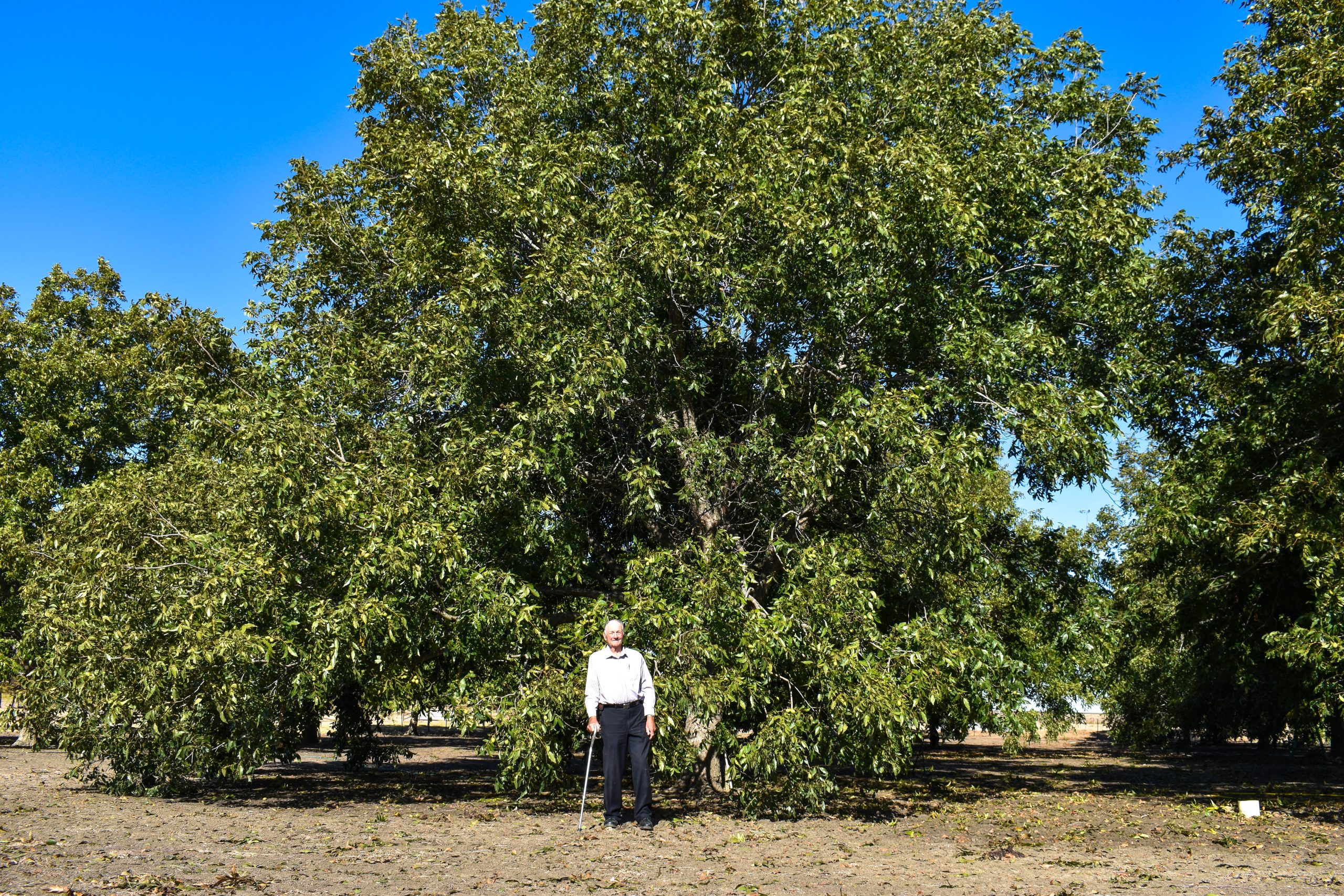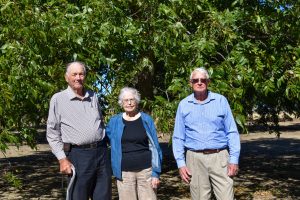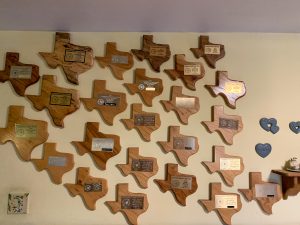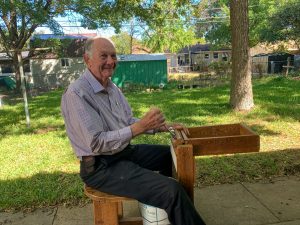A “Nutty Hobby” Becomes an Award-Winning Pecan Orchard
Robert Schuetze holds the most wins in Texas Pecan Show history and shares his secret for producing award-winning pecans.

Robert Schuetze, 92, stands in front of his 'GraTex' pecan tree in his small orchard near Cameron, Texas. Schuetze won Reserve Champion at the 1998 Texas Pecan Show with the nuts from this tree. He also went on to win Champion in the Classic division in 2001. (Photo by Catherine Clark)
For decades—if not centuries—pecan growers have sought answers to this complex question, and researchers have wrestled with uncovering the management practices that will lessen alternate bearing and bring the industry closer to producing top-notch nuts every year.
The quest for how to grow the perfect pecan is never-ending, though some growers get pretty close. High-tech equipment, complicated tracking methods, new management recommendations and practices—all help producers get closer to their goal. But still, there are other growers that seem to develop their own sort of system. And through that system, they discover perhaps one version of the secret.
Robert Schuetze, 92, is one of those growers. On a small plot of land near Cameron, Texas, Robert Schuetze grows about 30 trees and manages them entirely with the help of his wife, Doris, 88, and friend, Royce Watson, 82. The team of three does it all—spraying, harvesting, hand-pruning, pest management, irrigation, and shelling.

Robert and Doris Schuetze stand with their friend, Royce Watson, in the Schuetze’s small pecan orchard near Cameron, Texas. All three manage the orchard and care for the 30 trees, which include ‘Cheyenne,’ ‘Waco Wonder,’ ‘Sioux,’ ‘GraTex,’ ‘Kanza,’ ‘Oconee,’ ‘Forkert, ‘Navaho,’ and ‘Nacono’ cultivars. (Photo by Catherine Clark)
For Schuetze, growing pecans is not so much a business venture as a beloved hobby. Over the years, Schuetze has transformed his hobby into an award-winning orchard with no equipment and a modest approach to fertilizer. He currently holds the record for most wins in the Texas Pecan Show.
Robert Schuetze jumped into pecan growing when he and his wife, Doris, purchased their home in Waco. The house had a pecan tree, and he quickly decided to add a few more trees to get both shade and pecans. After a friend from work grafted some of his trees and taught him inlay grafting, Schuetze grafted all of the trees at his home into improved varieties.
His entry into pecan shows began in 1990. Schuetze had a large crop on his yard trees but noticed “some pecans were turning black and the shucks were not opening.”
“I contacted the County Agent, and he came out, and neither of us knew what caused the problem,” Schuetze writes in his retelling of his pecan show history. “While he was looking at my trees, he noticed I had what he said were very good pecans on another tree. He told me I needed to gather 40 of my best pecans and enter them in the McLennan County Pecan Show.”
Having never heard of a pecan show before, Schuetze gathered those 40 pecans and entered them into the show. “The Show Judge awarded me the first place blue ribbon on my pecans, and I was hooked,” he writes.
He continued to participate in pecan shows and submitted two more varieties the next year and won Champion Commercial pecan and Champion Classic in the 1991 McLennan County Pecan Show.
During this time, Schuetze also grafted several trees in his garden and transplanted them to the family’s small ranch in Milam County.
“In about 1989, we moved the first trees down here and then planted more from pecan seed in 1992,” he says.
Robert Schuetze ended up with 2 to 3 acres of pecan trees that began producing in 1995. Once his trees entered production, he began submitting those nuts to the pecan shows. With his first harvest in 1995, four of his five entries won first place in the county show and then were advanced onto the state Texas Pecan Show, where they received second place. “My aim was to get a blue ribbon at the state show, and then, of course, after you win something else, you get greedy,” he recalls with a laugh.
The nuts from Schuetze’s ‘GraTex’ tree won Reserve Champion at the Texas Pecan Show in 1998 and then Champion in the Classic division in 2001. “It has been our best producer,” he adds.
Pecan shows have been vehicles for education, knowledge-sharing, and friendly competition since the early to mid 1900s. The state-wide Texas Pecan Show began in 1950 and continues today at the Texas Pecan Growers Association Conference each summer.
“This idea of shows—showing, bringing your stuff to show—is a powerful educational tool for the public, and I think the pecan show is still an educational tool. It’s a bit of a historical name. We see that concept of showing stuff being lost largely, but it’s important,” says Dr. Monte Nesbitt, an Extension Program Specialist at Texas A&M AgriLife and the organizer for the Texas Pecan Show.

Some of Robert Schuetze’s many championships from the pecan shows over the years on display at his home in Waco, Texas. (Photo by Catherine Clark)
As of the 2021 crop, Robert Schuetze has won 50 blue ribbons, 8 Reserve Champions, and 5 Champions at the Texas Pecan Show. He has also won 146 blue ribbons and 33 Champions through the county pecan shows and 59 blue ribbons, 10 Reserve Champions, and 19 Champions at the regional pecan shows.
“There are different eras of the [Texas] Pecan Show, and when you’re the Grand Champion, it’s not by chance. You’re doing something right,” Nesbitt explains.
Nesbitt adds that Schuetze has also won Texas’ Native Championship several times with nuts that are sometimes good enough to propagate.
Schuetze started with about 100 trees and is now down to 30 after losing some to the 2011 drought and removing others due to crowding. As a smaller grower with limited help, his success is surprising in other ways as well.
“When I started this, I finally went to a pecan conference, and George Ray McEachern got up there on the stage and told me I couldn’t grow pecans here because I had no soil,” Schuetze shares. After studying and talking with pecan specialists, he somehow found success with his thick clay soil.
“The soil is not picture perfect. He’s not blessed with the very best pecan soil that we could describe in a textbook. This clay holds a lot of moisture. A lot of people with these soils will cause young trees to die or suffer because they overwater. They languish; they’re stunted. Part of Robert’s success is intuitively watering these trees on tricky soil,” Nesbitt says. “Not everybody can do that. We would not steer people looking to get into pecans to this clay soil; it’s a little bit harder to manage. But he’s figured it out to have this kind of tree development and the quality nuts.”
When selecting which pecans to enter into the show, Schuetze uses a grading scale to check the size and grade. “If my pecan is not at state standard or better, you’ll never see ’em,” he explains. “I weigh them, shell them, kernel them, and look at them.”
Through his work with pecan trees, Schuetze has helped discover new varieties that other growers have gone on to plant in their own groves and orchards. “I found ‘Waco Wonder’ in a lady’s yard. I went to eat with my neighbor, and he had a bowl on his table that had pecans in it,” Schuetze recalls. “I reached in and cracked one and said, ‘Fred, this is a good pecan. Where did you get it?’ He said, ‘Off of that tree.’ And I replied, ‘Fred, more important. Where did you get that tree?’”
After his neighbor explained that he believed the tree to be wild, planted by a bird or squirrel, Schuetze decided he would get a little limb. “He said, ‘Bob, what are you going to do with a limb?’ And I said, ‘I’ve got a little 2-foot tall tree that I’m going to go up there and graft it on it.’ And I did.”
This discovery of new cultivars is another aspect of the pecan show that Schuetze, other growers, and researchers find invaluable.
“The fact that [these varieties] can do well in the Texas Pecan Show brings attention to that variety, and sooner or later, other people that want to win the pecan show say, ‘Mr. Schuetze, where do I get one of those limbs and get a start of that?’” Nesbitt says.
Growing award-winning pecans isn’t without its challenges, though. Predation, drought, scab, and quality issues are familiar. Flooding is a significant challenge for Schuetze’s grove. The water can get waist-high, and when they receive heavy rain, the creek below the orchard fills and floods the property.
“Our biggest challenge is finding help or labor,” Schuetze says. Managing a small orchard is a lot of work for just three people—all advanced in age—and finding help through family members or other employees can be difficult.

Robert Schuetze shows off his homemade pecan cracking machine. Each year he uses this tool to hand-crack his harvested pecans.
Even with these challenges, Schuetze has spent years studying his trees. And through that study, he has learned how to produce high-quality pecans year after year.
“There are lots of things that I don’t know about. What I watch is the tree itself, and I cut pecans. I cut a lot of pecans,” he says.
By cutting the pecans while they’re developing, Schuetze says he understands just what is happening on his trees and can monitor the kernel development more closely. He also relies on the traditional good agricultural practices and advice from his local County Extension Agent and Texas AgriLife pecan specialists.
At 92 years old, Schuetze continues to maintain his pecan trees and aims to win another Championship at the Texas Pecan Show this year. So, what’s the secret? After winning hundreds of blue ribbons and a total of 57 Champions across all divisions of the pecan show, Robert Schuetze would surely know the answer to this elusive question.
“The secret? It’s unanswerable. No one knows,” he says. “I know three things are absolutely necessary: water, water, water. There are several other things—like fertilizer…But water is number one.”
But most importantly, Schuetze watches the trees. “If the tree could talk to me, I could do it absolutely perfect. Because it would tell me when it’s hungry; it would tell me when it needs something, but I can’t get them to talk,” Schuetze says. “I do hear some things from them. When I look at them and see the leaves are healthy and everything looks good, I know the tree is not suffering. There are things that you can learn from the tree, but I think that’s just something everyone has to learn in whatever ability you have.”

